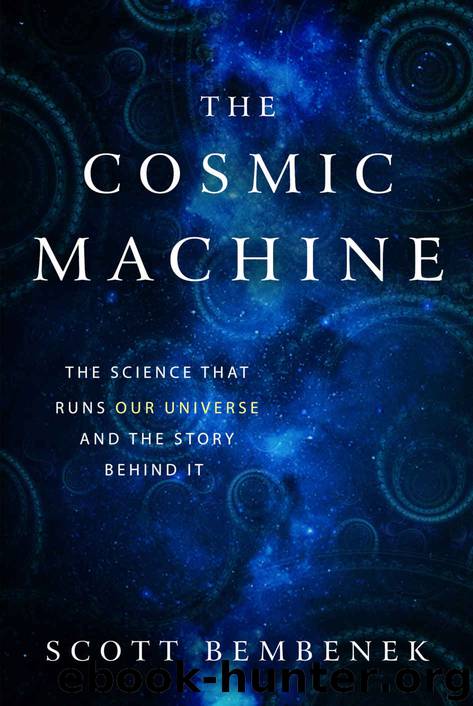The Cosmic Machine: The Science That Runs Our Universe and the Story Behind It by Scott Bembenek

Author:Scott Bembenek [Bembenek, Scott]
Language: eng
Format: epub
Tags: Science, Chemistry, Physical & Theoretical
ISBN: 9780997934106
Google: _dD7MAAACAAJ
Amazon: B074CPJ51S
Publisher: Zoari Press
Published: 2017-08-14T16:00:00+00:00
145 The timing couldn’t have been better because a new trend in experimental investigations was beginning. The days of simply making observations and recording data was giving way to a more critical process of experimentation. In 1620, Francis Bacon (1561–1626) wrote Novum Organum, which demanded a new approach to gathering and interpreting experimental data. In it he argues for an inductive rather than deductive approach to dealing with experimental data, and thus provided the starting pointing for the scientific method that we use today. He also argued that to really gain fundamental insight into nature one needed to put nature on the spot, so to speak. Bacon says it quite elegantly: “under constraint and vexed; that is to say, when by art and the hand of man she is forced out of her natural state, and squeezed and moulded.” Indeed, the Aristotelian approach of merely observing things in nature from afar was giving way to setting up experiments that allowed for the controlled observation of natural phenomena.
146 Lavoisier was very meticulous when performing his experiments. He emphasized quantitative experimental methods and the use of the chemical balance to carefully weigh the starting material and ending material. His chemical experiments disproved the phlogiston theory, which stated that phlogiston was something that was stored inside a substance, and that the act of burning it (combustion) caused it to be released. However, Lavoisier’s experiments showed that when a substance burns, it combines with oxygen in the process; burning or combustion is a process that involves your starting material combining with oxygen. Therefore, when the starting material combines with oxygen you get your ending material, which is actually heavier than your starting material. (In this example, we aren’t counting oxygen as a starting material.) If indeed fire was a release of phlogiston, one would expect combustion to result in a decrease in mass, whereas Lavoisier had clearly shown it increased.
147 However, sometimes there are starting materials left over, which is to say that not all of it was used up during the course of the chemical reaction. In this case, the amount left over along with the amount of ending materials have to equal the original amount of starting materials.
148 In 1644, Descartes wrote his major work, Principles of Philosophy. Here, he makes clear his rejection of action at a distance, and he proposed that all of space is filled with pieces of matter that interact via – you guessed it – direct contact. In 1687, Newton wrote Principia and in it his theory of gravity was one of action at a distance where objects, such as the planets, feel gravity through empty space without anything mediating this interaction directly. Newton accepted action at a distance perhaps only half-heartedly. With Einstein’s General Theory of Relativity, gravity is understood as resulting from the curvature of spacetime. Thus, matter curves spacetime with gravity arising from this curvature, spacetime affects the motion of matter, and action at a distance is eliminated. Action at a distance appears in
Download
This site does not store any files on its server. We only index and link to content provided by other sites. Please contact the content providers to delete copyright contents if any and email us, we'll remove relevant links or contents immediately.
Alchemy and Alchemists by C. J. S. Thompson(2909)
The Elements by Theodore Gray(2428)
The Club by A.L. Brooks(2352)
How to Make Your Own Soap by Sally Hornsey(2334)
Drugs Unlimited by Mike Power(2189)
Wheels of Life by Anodea Judith(1605)
Cracking the Sat French Subject Test, 2013-2014 Edition by The Princeton Review(1518)
The Cosmic Machine: The Science That Runs Our Universe and the Story Behind It by Scott Bembenek(1477)
Perfume by Jean-Claude Ellena(1466)
The Flavor Matrix by James Briscione(1360)
1000 Multiple-Choice Questions in Organic Chemistry by Organic Chemistry Academy(1349)
Cracking the LSAT, 2012 Edition by Princeton Review(1338)
MCAT Physics and Math Review by Princeton Review(1302)
Cracking the SAT Premium Edition with 6 Practice Tests, 2017 by Princeton Review(1249)
Synchrotron Light Sources and Free-Electron Lasers by Eberhard J. Jaeschke Shaukat Khan Jochen R. Schneider & Jerome B. Hastings(1234)
Handbook of Modern Sensors by Jacob Fraden(1221)
A is for Arsenic: The Poisons of Agatha Christie (Bloomsbury Sigma) by Kathryn Harkup(1211)
Harry Potter All Books: 8 Books by J.k.rowling(1186)
Cracking the AP English Language & Composition Exam, 2018 Edition by Princeton Review(1032)
